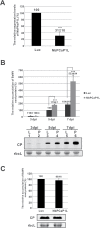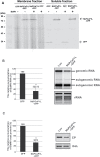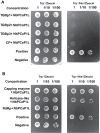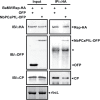Plasma membrane-associated cation-binding protein 1-like protein negatively regulates intercellular movement of BaMV
- PMID: 28992255
- PMCID: PMC5853580
- DOI: 10.1093/jxb/erx307
Plasma membrane-associated cation-binding protein 1-like protein negatively regulates intercellular movement of BaMV
Abstract
To establish a successful infection, a virus needs to replicate and move cell-to-cell efficiently. We investigated whether one of the genes upregulated in Nicotiana benthamiana after Bamboo mosaic virus (BaMV) inoculation was involved in regulating virus movement. We revealed the gene to be a plasma membrane-associated cation-binding protein 1-like protein, designated NbPCaP1L. The expression of NbPCaP1L in N. benthamiana was knocked down using Tobacco rattle virus-based gene silencing and consequently the accumulation of BaMV increased significantly to that of control plants. Further analysis indicated no significant difference in the accumulation of BaMV in NbPCaP1L knockdown and control protoplasts, suggesting NbPCaP1L may affect cell-to-cell movement of BaMV. Using a viral vector expressing green fluorescent protein in the knockdown plants, the mean area of viral focus, as determined by fluorescence, was found to be larger in NbPCaP1L knockdown plants. Orange fluorescence protein (OFP)-fused NbPCaP1L, NbPCaP1L-OFP, was expressed in N. benthamiana and reduced the accumulation of BaMV to 46%. To reveal the possible interaction of viral protein with NbPCaP1L, we performed yeast two-hybrid and co-immunoprecipitation experiments. The results indicated that NbPCaP1L interacted with BaMV replicase. The results also suggested that NbPCaP1L could trap the BaMV movement RNP complex via interaction with the viral replicase in the complex and so restricted viral cell-to-cell movement.
Keywords: Bamboo mosaic virus; NbPCaP1L; Nicotiana benthamiana; defense protein; positive-sense RNA virus; replicase; viral RNA movement.
© The Author 2017. Published by Oxford University Press on behalf of the Society for Experimental Biology.
Figures






Similar articles
-
An E3 ubiquitin ligase from Nicotiana benthamiana targets the replicase of Bamboo mosaic virus and restricts its replication.Mol Plant Pathol. 2019 May;20(5):673-684. doi: 10.1111/mpp.12784. Epub 2019 Mar 29. Mol Plant Pathol. 2019. PMID: 30924604 Free PMC article.
-
A thioredoxin NbTRXh2 from Nicotiana benthamiana negatively regulates the movement of Bamboo mosaic virus.Mol Plant Pathol. 2018 Feb;19(2):405-417. doi: 10.1111/mpp.12532. Epub 2017 Mar 12. Mol Plant Pathol. 2018. PMID: 28052479 Free PMC article.
-
The Lipid Transfer Protein 1 from Nicotiana benthamiana Assists Bamboo mosaic virus Accumulation.Viruses. 2020 Nov 27;12(12):1361. doi: 10.3390/v12121361. Viruses. 2020. PMID: 33261222 Free PMC article.
-
Viral elements and host cellular proteins in intercellular movement of Bamboo mosaic virus.Curr Opin Virol. 2015 Jun;12:99-108. doi: 10.1016/j.coviro.2015.04.005. Epub 2015 May 13. Curr Opin Virol. 2015. PMID: 25951346 Review.
-
Host Factors in the Infection Cycle of Bamboo mosaic virus.Front Microbiol. 2017 Mar 15;8:437. doi: 10.3389/fmicb.2017.00437. eCollection 2017. Front Microbiol. 2017. PMID: 28360904 Free PMC article. Review.
Cited by
-
Disrupting the Homeostasis of High Mobility Group Protein Promotes the Systemic Movement of Bamboo mosaic virus.Front Plant Sci. 2020 Dec 16;11:597665. doi: 10.3389/fpls.2020.597665. eCollection 2020. Front Plant Sci. 2020. PMID: 33424893 Free PMC article.
-
An E3 ubiquitin ligase from Nicotiana benthamiana targets the replicase of Bamboo mosaic virus and restricts its replication.Mol Plant Pathol. 2019 May;20(5):673-684. doi: 10.1111/mpp.12784. Epub 2019 Mar 29. Mol Plant Pathol. 2019. PMID: 30924604 Free PMC article.
-
Comparative Proteomic Analysis of Two Contrasting Maize Hybrids' Responses to Low Nitrogen Stress at the Twelve Leaf Stage and Function Verification of ZmTGA Gene.Genes (Basel). 2022 Apr 11;13(4):670. doi: 10.3390/genes13040670. Genes (Basel). 2022. PMID: 35456476 Free PMC article.
-
Trade-off between local replication and long-distance dissemination during experimental evolution of a satellite RNA.Front Microbiol. 2023 Aug 4;14:1139447. doi: 10.3389/fmicb.2023.1139447. eCollection 2023. Front Microbiol. 2023. PMID: 37601360 Free PMC article.
-
The gibberellic acid derived from the plastidial MEP pathway is involved in the accumulation of Bamboo mosaic virus.New Phytol. 2022 Aug;235(4):1543-1557. doi: 10.1111/nph.18210. Epub 2022 Jun 22. New Phytol. 2022. PMID: 35524450 Free PMC article.
References
-
- Agre P, Bonhivers M, Borgnia MJ. 1998. The aquaporins, blueprints for cellular plumbing systems. The Journal of Biological Chemistry 273, 14659–14662. - PubMed
-
- Baurès I, Candresse T, Leveau A, Bendahmane A, Sturbois B. 2008. The Rx gene confers resistance to a range of potexviruses in transgenic Nicotiana plants. Molecular Plant-Microbe Interactions 21, 1154–1164. - PubMed
-
- Benitez-Alfonso Y, Faulkner C, Ritzenthaler C, Maule AJ. 2010. Plasmodesmata: gateways to local and systemic virus infection. Molecular Plant-Microbe Interactions 23, 1403–1412. - PubMed
Publication types
MeSH terms
Substances
LinkOut - more resources
Full Text Sources
Other Literature Sources
Research Materials

